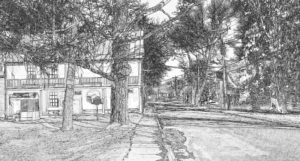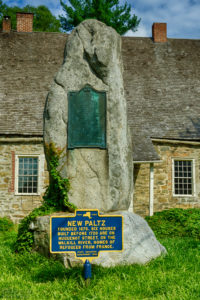
In 1675 Abraham Hasbrouck joined his brother Jean and the little band of Huguenots living in Hurley N.Y., some of whom they had known in Mannheim. Soon afterward this group was able to fulfill its 10-year-old dream for a French settlement of its own.
New Paltz was unique at its very inception. Five years before William Penn’s treaty with the Indians, this group of Huguenots first approached the Esopus Indians, the true owners of the land they desired. The purchase price of sturdy tools, good cloth, even horses, was hardly a bargain by Dutch or English standards. The contract of sale, signed by five Esopus chiefs, and the confirmatory deed by 21 Esopus braves, preceded the royal (patent) grant given under the hand of Governor Edmund Andros on September 29, 1677. All three documents are now at the Huguenot Historical Society Museum. They built the “Redoute” required by the governor as “a place of Retreat and Safeguard upon Occasion,” but never, even during the troubled Revolutionary period, was this settlement in danger of Indian attack.

In 1678 then, the twelve Patentees and their families proceeded to their new home. Upon reaching their destination on the east bank of the Wallkill River, they built simple wood houses, which were replaced by stone dwellings in the early 1700’s. They named the place New Paltz in honor of Pfalz-am-Rhein (the German state including Mannheim) where they had found refuge from the persecutions of Louis XIV. The people owned the land in common, and by that arrangement the product of their labors went into the common store. For fifty years the heads of the twelve families met in legislative and executive session to administer the affairs of New Paltz. In 1728, owing to the fact that Dutch inhabitants were increasing in number, the twelve men were elected by popular vote of all the property owners in the community. The council was called “DUZINE”, meaning twelve. They apparently exercised rather wide powers, so that their enactments had to be ratified by an Act of the Legislature, confirming unto the owners the partition of land made by the “twelve men” dated 1785 and signed by Governor George Clinton. The Duzine continued to function until 1826.
